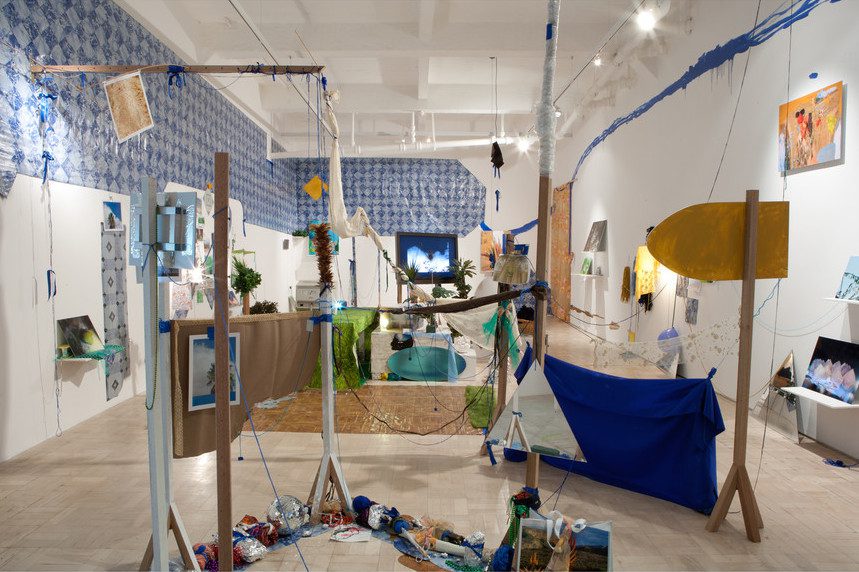The four recipients selected this year were Dineo Seshee Bopape, İnci Eviner, Uriel Orlow and Walid Siti. A special prize was awarded to the late Ali Jabri and will be dedicated to the conservation of his work.

Dineo Seshee Bopape. queen of necklace sketch II, 2010, Mixed media, Stevenson Cape Town. Photograph: © Dineo Seshee Bopape. Courtesy of Stevenson Cape Town, Johannesburg.
During Sharjah Biennial 13: Tamawuj Act 1 opening, Sharjah Art Foundation (SAF) announced the recipients of the Sharjah Biennial Prize.
For the 13th edition of the Sharjah Biennial (SB13), which runs from 10 March to 12 June 2017, curator Christine Tohme invited more than 70 artists to respond to the thematic focus of SB13, grounded in the four keywords water, crops, earth and culinary. Since 1993, a selection of participating artists from each biennial has been chosen by a distinguished jury to receive the Sharjah Biennial Prize.
The jurors for the 2017 edition were Dr Yousif Aydabi, Cultural Advisor at the Dr Sultan Al Qasimi Centre for Gulf Studies in Sharjah, N’Goné Fall, independent curator and co-founder of GawLab Collective in Dakar and Adriano Pedrosa, Artistic Director of Museu de Arte de São Paulo Assis Chateaubriand (MASP).
The four recipients selected this year were (in alphabetical order) Dineo Seshee Bopape, İnci Eviner, Uriel Orlow and Walid Siti. A special prize was awarded to the late Ali Jabri and will be dedicated to the conservation of his work.
Dineo Seshee Bopape‘s installation +/- 1791 (monument to the haitian revolution 1791) (2017) draws parallels between the political liberation of a land, spiritual liberation through revolt and the biological sustenance and sense of nuturing offered by the earth.
İnci Eviner has explored the perspective of women, processes of organisation and the formation of subjectivities for 40 years. In SB13, she presents two videos that reflect on art, politics and life. One of these works, Beuys Underground, is an SB13 commission (2017).
Uriel Orlow’s multi-component Theatrum Botanicum (2016) envisions the botanical world as both witness to and actor in the enduring legacy of colonialism in South Africa.
For SB13, Walid Siti created Phantom Land (2017), which explores one’s relationship to heritage, home, borders, mobility and migration, and False Flags(2017), which reflects on one’s fragile attachement to iconic emblems of identity.
Ali Jabri was a critical chronicler of the everyday with a passion for archaeology and cultural heritage. His formative years coincided with the fertile period of Arab nationalism from the 1940s to the 1970s. SB13 pays homage to Jabri in a presentation focusing on his lesser known collage works, including Untitled (1989–92) that allegorises the artist’s disenchantment with the modern Arab world.
Act I of SB13 opened with a public ceremony in the presence of HH Sheikh Dr Sultan Bin Mohammed Al Qasimi, Member of the UAE Federal Supreme Council and Ruler of Sharjah; Sheikha Hoor Al Qasimi, President and Director, Sharjah Art Foundation; and SB13 Curator, Christine Tohme. Between 10 and 14 March, an international gathering of artists, curators, museum directors, press and local audiences took excursions to the Biennial’s venues across the Emirate, including the new multi-purpose artist studios and exhibition spaces in Al Hamriyah. They also attended a series of special events, performances and film screenings, including SAF’s annual March Meeting, featuring presentations and panels.
Additional information about the ongoing SB13 Community and Outreach Programme, Film Programme, SB13 School and Education Programme is available online.
.
http://sharjahart.org/biennial-13
More Editorial